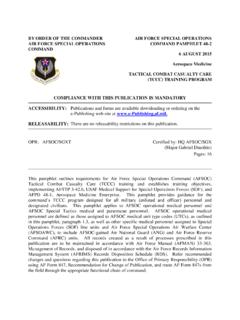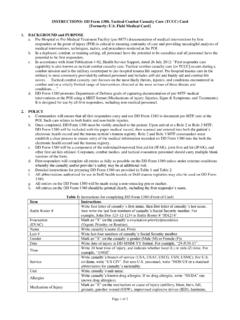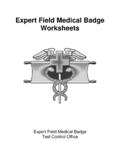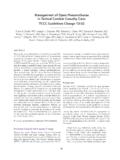Transcription of MILITARY COMMITTEE MEDICAL STANDARDIZATION …
1 NATO/PfP UNCLASSIFIED NATO STANDARDIZATION Agency Agence OTAN de normalisation B-1110 Brussels, Belgium Internet site: MILITARY COMMITTEE MEDICAL STANDARDIZATION BOARD (MCMedSB) 16 December 2009 NSA(MED)1420(2009)MEDSTD/2122 MCMedSB STANAG 2122 MEDSTD (EDITION 3) (RATIFICATION DRAFT 1) REQUIREMENT FOR TRAINING IN FIRST-AID, EMERGENCY care IN combat SITUATIONS AND BASIC HYGIENE FOR ALL MILITARY PERSONNEL Reference: MAS(ARMY)(75)621 dated 10 December 1975 (Edition 2) 1. The enclosed STANAG s ratification draft has been prepared by the custodian for circulation to obtain national ratification. ACTION BY NATIONAL STAFFS - RATIFICATION 2. Ratifying Reference. Nations prepared to ratify the STANAG are requested to include in their reply, a single co-ordinated national ratifying reference number, which will be recorded at NSA and made available on the NSA websites.
2 3. Date of Implementation. Nations that ratify the STANAG are requested to specify a date of implementation, which may be stated as a number of months following promulgation of the STANAG for the services to which it applies ( DOP or DOP + 3m). 4. Reservations. Nations prepared to ratify the STANAG but with reservations, are requested to state these in detail, so that they can be recorded at NSA and made available on the NSA websites. Nations should describe any portion of the STANAG which cannot be implemented and/or any portion which can only be implemented with limitations. (As this is implicit, Nations need not state, This STANAG is applicable only to future procurement ). 5. Non-Participation. Nations may elect to be registered as Not Participating and may indicate (or revoke) such status at any stage of the validation process.
3 A nation s non-participation will be taken into account by the TA when setting/reviewing promulgation criteria for the STANAG and non-participating nations will be expected to make a fresh declaration at the issue of each new ratification draft. E-mail: Tel Fax NATO/PfP UNCLASSIFIED NATO/PfP UNCLASSIFIED 6. Non-Ratifying. Nations not wishing to ratify the STANAG are requested to indicate their intention and if possible give their reasons for not ratifying, or their suggested changes, which would make it acceptable. Non-ratification by a nation is not to be construed as a bar to the promulgation of the STANAG. ACTION BY NATIONAL STAFFS -IMPLEMENTATION 7. After the STANAG has been implemented, nations are to complete the appropriate annex of AAP-3 and forward this to the relevant TA.
4 The TA will also monitor the intended dates of implementation provided by nations and may seek confirmation of the date of implementation if responses have not been provided by nations. ACTION BY THE NATO STRATEGIC COMMANDS (SCs) 8. SCs are requested to review the agreement and forward their comments. FORWARDING REPLIES 9. National staffs are to complete the appropriate annex of AAP-3 for replies and forward it through their national delegation as appropriate. SCs are to forward their replies in accordance with Command Operating Instructions. 10. Replies should reach the Joint Branch NSA by 16 March 2010. ~op , J. DRONIA Colonel, DEU(AF) Co-Chairman, MCMedSB Enclosure: STANAG 2122 (Edition 3) (Ratification Draft 1) NATO/PfP UNCLASSIFIED NATO/PfP UNCLASSIFIED 1 NATO/PfP UNCLASSIFIED STANAG 2122 (Edition 3) (Ratification Darft 1) NATO STANDARDISATION AGREEMENT (STANAG) REQUIREMENT FOR TRAINING IN FIRST-AID, EMERGENCY care IN combat SITUATIONS AND BASIC HYGIENE FOR ALL MILITARY PERSONNEL ANNEX: A.
5 Training Modules in First-Aid, Emergency care in combat situations and Basic Hygiene for all MILITARY personnel Related Documents: STANAG 2126 MED First-Aid Kit and Emergency care Kit STANAG 2358 CBRN/MED First Aid and Hygiene Training in NBC Operations AIM 1. The aim of this agreement is to standardize the training requirement for First-Aid, Emergency care in combat situations and Basic Hygiene for all MILITARY personnel within the NATO Forces. AGREEMENT 2. Participating nations agree to use Annex A as a the basic training program for all MILITARY personnel in First-Aid, Emergency care in combat situations and Basic Hygiene. METHODS OF TRAINING 3. Training will be provided as: a. Lectures by qualified personnel, in accordance with the directives of national MEDICAL authorities b.
6 Demonstrations and simulations c. Practical exercises in the field 4. Training will be followed by assessment. GENERAL 5. The knowledge and skills described in ANNEX A should have been acquired before personnel are deployed abroad. IMPLEMENTATION OF THE AGREEMENT 6. This STANAG is implemented when a nation has issued the necessary order/instructions to the forces concerned putting the policy detailed in this agreement into effect NATO/PfP UNCLASSIFIED A - 1 NATO/PfP UNCLASSIFIED ANNEX A TO STANAG 2122 (Edition 3) (Ratification Darft 1) Training Modules in First-Aid, Emergency care in combat situations and Basic Hygiene for all MILITARY Personnel CHAPTER 1. GENERAL 101. Potential participants All deployable personnel. 102. Content and duration Module 1.
7 First Aid (appr. 30 hours) Module 2. Emergency care in combat situations (appr. 15 hours) Module 3. Basic Hygiene (appr. 4 hours) NATO/PfP UNCLASSIFIED A - 2 NATO/PfP UNCLASSIFIED CHAPTER 2. TRAINING MODULES 201. MODULE 1. FIRST AID 1. Purpose To give all MILITARY personnel basic knowledge and skills in order to: a. Prevent the situation from getting worse b. Provide cardio-pulmonary resuscitation if required c. Stabilize a wounded/sick person d. Provide care until MEDICAL personnel arrives e. Perform self-aid/buddy-aid 2. Recommended duration Appr. 30 hours 3. Objectives The participants should be able to: a. Site Survey: (1) Secure the scene (2) Perform triage as described in Appendix 1 (3) Transport a casualty, alone or with a helper b.
8 Primary Survey: (1) Stop visible major bleeding (2) Secure the airway, with cervical spine control (3) Treat life threatening thoracic injuries by use of appropriate bandage technique (4) Assess for shock (5) Perform cardio-pulmonary resuscitation if required (6) How to use the AED (Automatic External Defibrillator) if appropriate, by the nation. (7) Position the unconscious patient NATO/PfP UNCLASSIFIED A - 3 NATO/PfP UNCLASSIFIED c. Secondary Survey Manage the following: (1) Body temperature (2) Fractures (3) Distortions and muscles damages (4) Burns (5) Eye lesions (6) Drowning (7) Poisoning, including carbon monoxide (8) Psychological distress Know the symptoms of: (1) Heat/sun/cold exposure (2) Dehydration (3) Feet problems (4) Altitude problems (5) Diarrhoea and its avoidance d.
9 Use the First-Aid equipment as described in STANAG 2126. NATO/PfP UNCLASSIFIED A - 4 NATO/PfP UNCLASSIFIED 202. MODULE 2. EMERGENCY care IN combat SITUATIONS 1. Purpose To enable all MILITARY personnel understand and perform emergency care under the restrictions posed by the tactical situation. 2. Prerequisite Previous training in First-Aid. 3. Recommended duration Appr. 15 hours. 4. Objectives The participants should be able to perform: a. care under fire: (1) Protect self, scene and survivors within national rules of engagement. (2) Direct casualty to move to cover and apply self-aid if able. (3) Stop life-threatening external haemorrhage by using tourniquet if tactically feasible. (4) Airway management is generally best deferred until the Tactical Field care phase.
10 (5) Place the unconscious casualty in the prone position. b. Tactical Field care : (1) Casualties who are suspected to have an altered mental status should be disarmed immediately. (2) Perform triage if indicated (3) Airway Management a. Unconscious casualties without airway obstruction: - Chin lift or jaw thrust manoeuvre. - Nasopharyngeal airway (at national discretion) - Place casualties in recovery position b. Casualty with airway obstruction or impending airway obstruction - Chin lift or jaw thrust manoeuvre. - Nasopharyngeal airway (at national discretion) - Allow casualty to assume any position that best protects the airway, to include sitting up.






